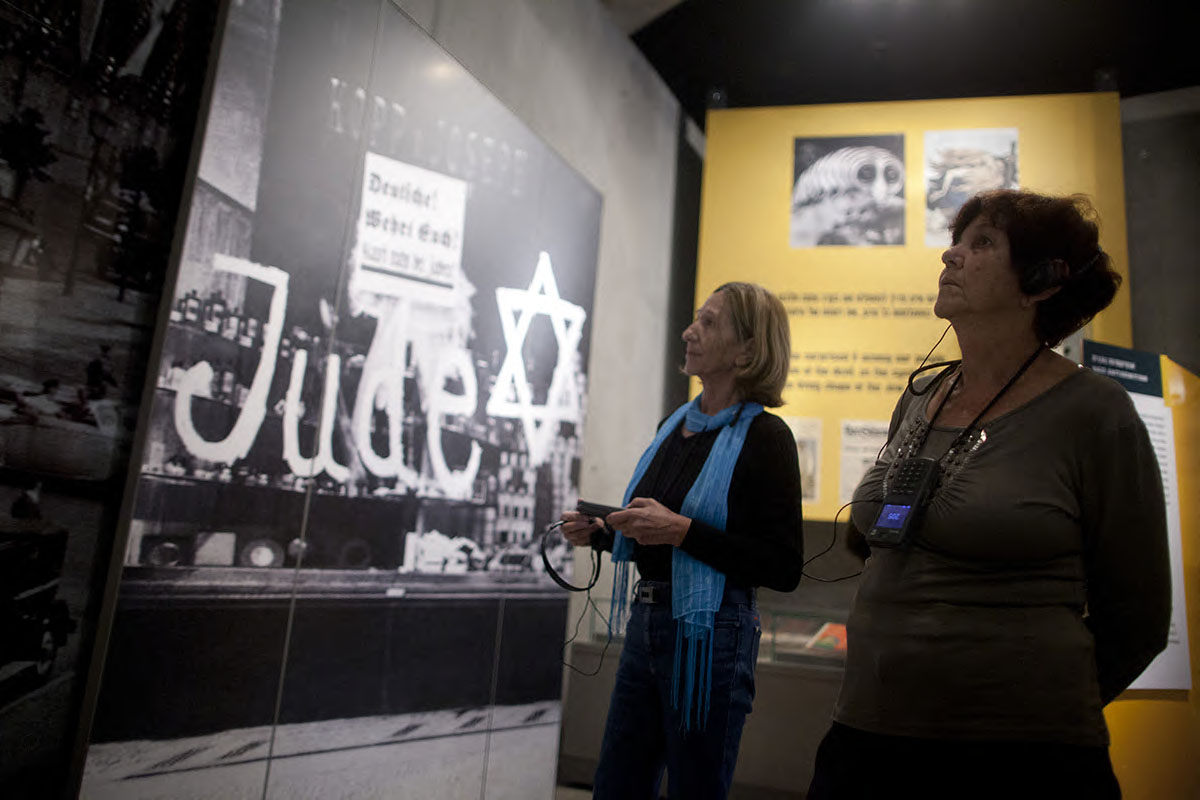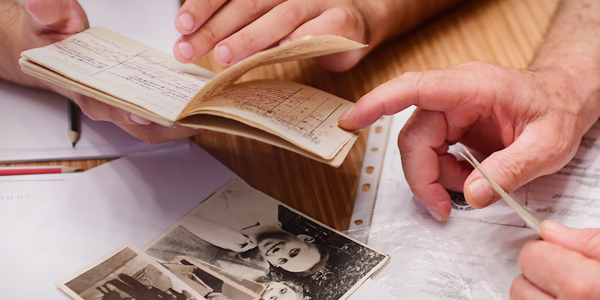In January 1939 the authorities forced the district rabbi of Würzburg, Rabbi Dr. Sigmund (Shimon) Hanover, who had meanwhile been detained in a concentration camp, to leave Germany. He was succeeded in office by Rabbi Dr. Magnus (Menachem) Weinberg, who was to be the last rabbi of the community in Würzburg before its destruction.








From the deportation album of the Jews of Mainfranken (part of Lower Franconia).
The handwritten captions under the photographs is at times of an anti-Semitic nature.
"The Jewish Mischpoche (family) arrives in herds at the evacuation point…"
"The Jewish scum is being loaded…"
"The later the hour, the more handsome the guests…"
"On foot and by car the Jews stream in…"
Courtesy of the Würzburg State Archives (Staatsarchiv Würzburg)
Yad Vashem Photo Archives 7900/94-99
In September 1941 the Jews of Germany were made to wear the "yellow badge" on their clothes; all Jews from the age of six were to wear a yellow star on their outer garments. In October 1941 Jews were prohibited from crossing the Reich borders, and November 1941 was the first occasion on which Jews from Würzburg were deported to Riga.
At the beginning of 1942 the authorities dictated that all Jewish apartments in Würzburg be vacated. Their owners were concentrated in the buildings of the Jewish cemetery, under extremely crowded conditions and without any privacy: families were quartered in the mourning room, the eulogy chamber, the prayer room and the guard room, and several families were also placed on the second floor. Jews who had been sent to Würzburg from other communities in Franconia were concentrated in the Jewish hospital. Older Jews, both men and women, were conscripted to serve as force laborers in factories, street cleaning, loading and unloading trains, and other similar tasks. Strict regulations controlled the movement of Jews in the city.
Between 1933, when the Nazi party came to power, and 1942, some 2,300 Jews left Würzburg, among them Jews who had immigrated to the city or been deported to it from other communities in Germany. A quarter of the emigrants from Würzburg resettled elsewhere Germany; the rest left the country, most of them for the United States, Eretz Israel, and Great Britain.
According to a Gestapo report from Würzburg, between November 1941 and June 1943, 2,063 Jews were deported. From Lower Franconia in six transports, among them the Jews of Würzburg. Before boarding the transports the deportees were required to hand in all their valuables, the keys to their apartments, and a document detailing their property, including their bank account details. They were only allowed to take a few belongings with them on the trains. Before boarding the transports they were registered and meticulously searched for contraband objects and other goods which were not allowed to be taken. The deportees were routed to Nuremberg, from where about a third of them were transported to Theresienstadt and the rest – "to the East". Michael Völkl, the Gestapo officer in charge of the deportations from Würzburg, assigned German policemen the task of documenting three of the transports. Other photography of the deportation process was strictly forbidden.
The Deportations from Lower Franconia
- 27 November 1941, 202 Jews from Würzburg were deported to Riga.
-
, 208 Jews were deported from Kitzingen to Izbica, Poland, among them 24 Jews from Würzburg.
- 25 April 1942, 850 Jews were deported from Würzburg to Krasnystaw; 78 of the deportees were from Würzburg, and the remaining deportees came from some 80 different communities.
-
, 177 Jews were deported from Würzburg to Theresienstadt.
-
, 562 Jews were deported from Würzburg to Theresienstadt.
-
, seven Jews were deported from Würzburg to Theresienstadt, and 57 Jews were deported to Auschwitz.
The community was officially liquidated on September 22, 1943. Several days before this date, the remaining Jews brought a wooden crate containing 25 Torah scrolls to the Jewish cemetery, where they buried it in the ground. A tombstone was placed over the grave, with the marking "The Mosaic Torah". The incident went unnoticed by the authorities, as at the time there were many deaths and suicides among the Jews in Würzburg.
Following the final deportation 29 Jews remained in Würzburg, of them 14 were originally residents of the city; the rest were Jews who had been brought in from surrounding communities. Five of the Jews were the children of mixed marriages, considered Jews according to Nazi racial law (Geltungsjuden); the others were Jews married to Germans.
Related Resources
- The End of the Jewish Community of Würzburg - Rabbi Dr. Hanover's Letter
- Letters sent by Marta Salmang from Würzburg to her cousin Hans Popper in Stockholm, Sweden






